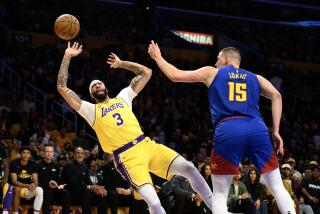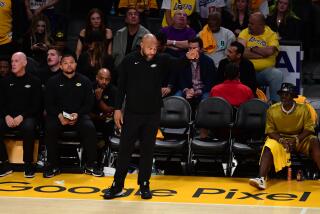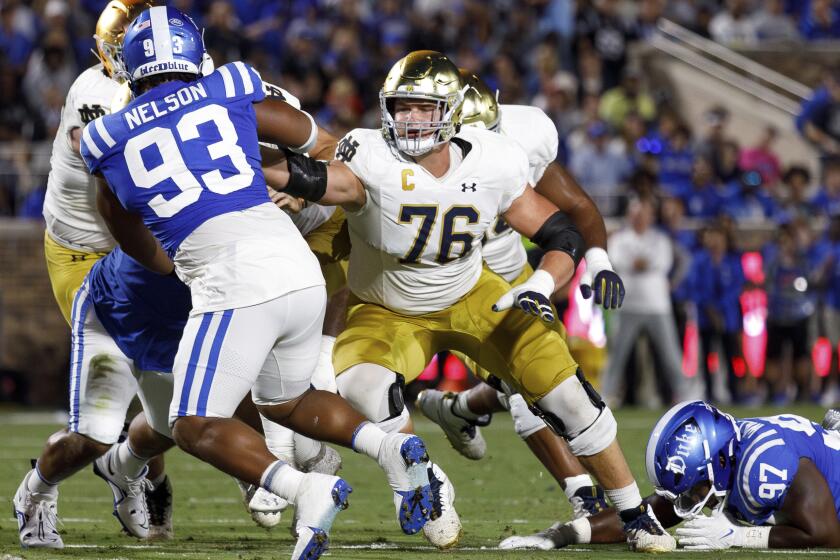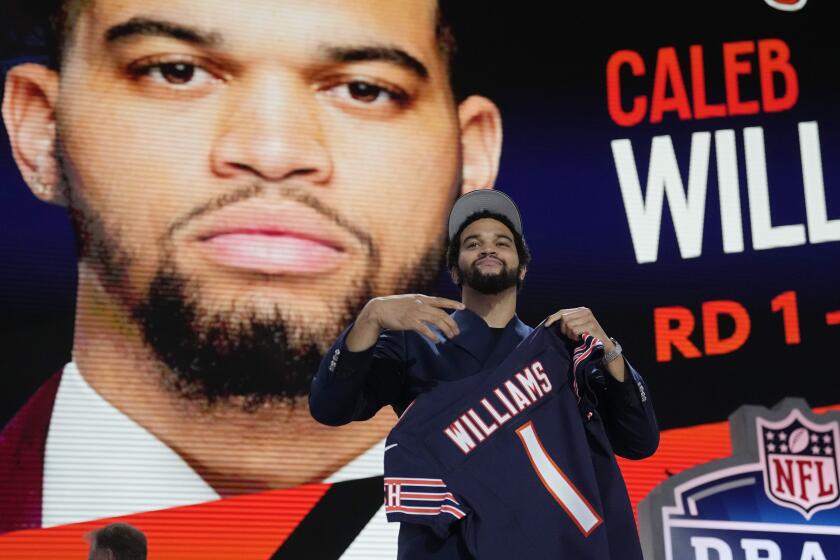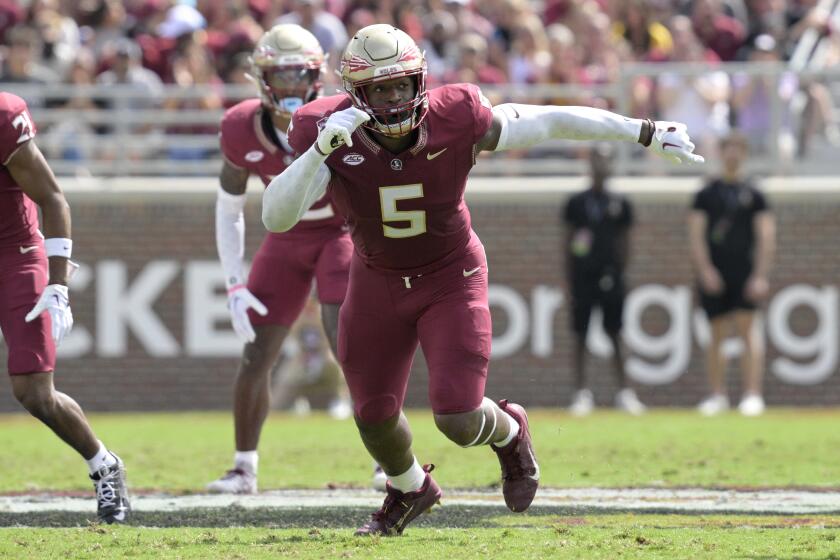A little snow would go a long way in the Super Bowl
A snowbound Super Bowl?
Yes, please.
If last weekend’s NFL games reminded us of anything, it’s that snow makes everything interesting. It turns the nation’s No. 1 sport into a goofy game show, with contestants struggling to perform impossible tasks, such as snapping the football or finding the line of scrimmage.
Detroit fumbled seven times in a Philadelphia blizzard.
That kind of backdrop for the league’s marquee event would be fascinating.
The Super Bowl could go from a blackout in New Orleans to a whiteout in New Jersey.
“The possibility of snow weighs on many people’s minds, some out of curiosity, some out of fear and some out of hope,” said Al Kelly, president and chief executive of the NY/NJ Super Bowl Host Committee. “I put myself in the category of a little bit of snow adds to the romance and reality of a cold-weather, outdoor, Northeastern Super Bowl.”
Emphasis on “little bit” of snow. Kelly said he certainly wouldn’t wish for enough snow that it interferes with the game or presents a public-safety issue.
The Farmer’s Almanac predicts a heavy storm to move into the area around the time of the Feb. 2 Super Bowl. So there could be tens of millions of people watching it from the comfort of their couches, while the fans at MetLife Stadium would be living in a Siberian snow globe.
There have been rare occasions of inclement weather at the Super Bowl, the coldest of which was 39 degrees at Tulane Stadium in New Orleans in January 1972, when Dallas beat Miami. There was a brief but torrential rainstorm when Indianapolis beat Chicago in Miami seven years ago.
For the most part, though, weather has been a non-issue at Super Bowls. This is the first such game played outdoors in a cold-weather city. It’s also the first Super Bowl hosted by two teams, the Giants and Jets; by two states, New York and New Jersey; and the first played in the Northeast.
“It may or may not usher in a new era,” said Frank Supovitz, the NFL’s senior vice president of events. “At the end of the day, it’s the 32 owners of the NFL that decide where Super Bowls are going to go. If they’re pleased with the results of this Super Bowl, they may open it up to additional cities.”
For a lot of people, Super Bowls tend to run together. One doesn’t stand out from the next. But no one would forget a snowy Super Bowl, with the winner being the team that better handles the elements. That’s true football.
“To have a battle between a couple of those teams in the Super Bowl, that would be awesome,” Eagles tight end Brent Celek said in a phone interview this week. “There’s a mystique to playing in snow.”
That was the case in Philadelphia’s 34-20 victory over the Lions on Sunday, a game so snowy the players looked like shadowy ghosts on TV, the broadcast a throwback to the days of picking up a grainy signal with rabbit ears.
It’s all about the players adjusting, which they did. All but eight of the 54 points in that game were scored in the second half.
“Guys were realizing that if you just run in a straight line and make one little cut, everyone’s falling,” Celek said. “You watch guys running down on kickoff, and it’s the most hilarious thing I’ve ever seen. Guys are scooting around. You look like third-graders out there.
“Before every play, everybody looked like cattle because they were kicking all the snow away from where they were to try to get footing. You’d get ticked off because the guy next to you would be kicking all his snow into your spot. Then, you’d try to kick it on the defense, and they’d be kicking it back on you.”
The Lions-Eagles game featured the most snow by far last weekend, but there was also snow and bitter-cold conditions at games between Kansas City and Washington, Minnesota and Baltimore, and Miami and Pittsburgh. The playing surfaces were clearer at those games, whereas Philadelphia’s field was blanketed, and Fox used a new technology to superimpose the field markings for viewers. Workers used heated blowers to reveal the essential lines.
“It was 8 inches deep at some points,” Celek said. “When we got up close to the goal line, you couldn’t see the goal line, so they had to come out and shovel it. Isn’t that crazy?”
Maybe so, but it’s not crazy to think that history could repeat itself in a couple of months, with the average Feb. 2 temperatures for East Rutherford ranging from 20 to 39 degrees. Unlike some fields equipped with a heating element underneath, the MetLife Stadium playing surface is not heated.
“There will be a very high standard to field maintenance,” Supovitz said. “The snow, if it’s falling during the game, needs to be cleared from the 10-yard lines, the sidelines, and to the degree we can get the hashes cleared we’ll do that as well. It really is like any given Sunday in stadiums that are open to the elements. This will be no different, we just need to be ready for it.”
NFL rules allow for the clearing of sidelines, goal lines and end lines. It’s also permissible to clear lines in 10-yard intervals. It is never permissible, though, to use any equipment to clear space for a field goal or an extra point, although players are allowed to use their hands and feet to clear snow in those situations.
In case weather conditions make play impossible, the NFL has the flexibility to move the game either by hours or by a day or more.
“These contingencies exist for every game,” Supovitz said. “We have had to move games, either kickoff times or in some cases the day. A plan for that is in place for this as well.”
One of the most amazing parts of a Super Bowl is the halftime show, and the orchestration that’s required to assemble and disassemble an elaborate stage with the efficiency of a NASCAR crew. But the setup at MetLife is different because much of the staging is built into a wall of the stadium along the sideline, so that will not require as many stage pieces on the actual field.
The NFL, the host committee and New York City are embracing the possibility of snow. They are building an eight-lane, 180-foot toboggan ride in Times Square and shutting down a 13-block stretch of Broadway for a four-day “Super Bowl Boulevard” festival. The host committee has already raised more than $6 million for its aptly named Snowflake Youth Foundation.
“If it snows, it snows,” Supovitz said. “If there was a light snow during the game, it would make for incredible television and an incredible live experience.”
And a heavy snow?
Celek, for one, would love that -- regardless of whether the Eagles were there.
“The people in the stands at our game said they’ll never forget it for the rest of their lives,” he said. “So what does that tell you about what the weather meant for that game?
“The snow just makes people happy.”
--
--
(BEGIN TEXT OF INFOBOX)
Super cold
Temperatures at kickoff for coldest outdoor Super Bowls, according to the Pro Football Hall of Fame:
*--* WHEN SITE SCORE TEMP Jan. 1972 Tulane Stadium, New Dallas 24, Miami 3 39 Orleans Jan. 1975 Tulane Stadium, New Pittsburgh 16, 46 Orleans Minnesota 6 Jan. 1974 Rice Stadium, Houston Miami 24, Minnesota 7 50 Jan. 1985 Stanford Stadium, Palo San Francisco 38, Miami 53 Alto 16 Jan. 1976 Orange Bowl, Miami Pittsburgh 21, Dallas 17 57 *--*
More to Read
Get our high school sports newsletter
Prep Rally is devoted to the SoCal high school sports experience, bringing you scores, stories and a behind-the-scenes look at what makes prep sports so popular.
You may occasionally receive promotional content from the Los Angeles Times.
